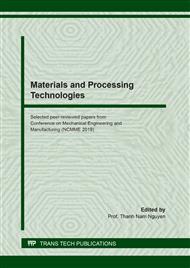p.33
p.51
p.59
p.67
p.73
p.79
p.85
p.97
p.103
Estimate the Melt Flow Length with Internal Induction Heating for the Injection Molding Process
Abstract:
In this paper, an induction heating system was applied to the heating stage in the injection molding process. Through simulation and experiment, the heating process was estimated by the temperature distribution and the heating rate. In the simulation, the mold temperature was increased from 30°C to 180°C in 9 s. Therefore, the heating rate was higher than 16°C/s, which represents a positive result in the field of mold heating. Additionally, the temperature distribution revealed that the higher temperature is concentrated on the gate area, while the outside of the mold cavity is at a lower temperature. The same parameters were applied to both the experiment and the simulation, and the results were in good agreement.
Info:
Periodical:
Pages:
97-102
Citation:
Online since:
September 2020
Authors:
Price:
Сopyright:
© 2020 Trans Tech Publications Ltd. All Rights Reserved
Share:
Citation:


